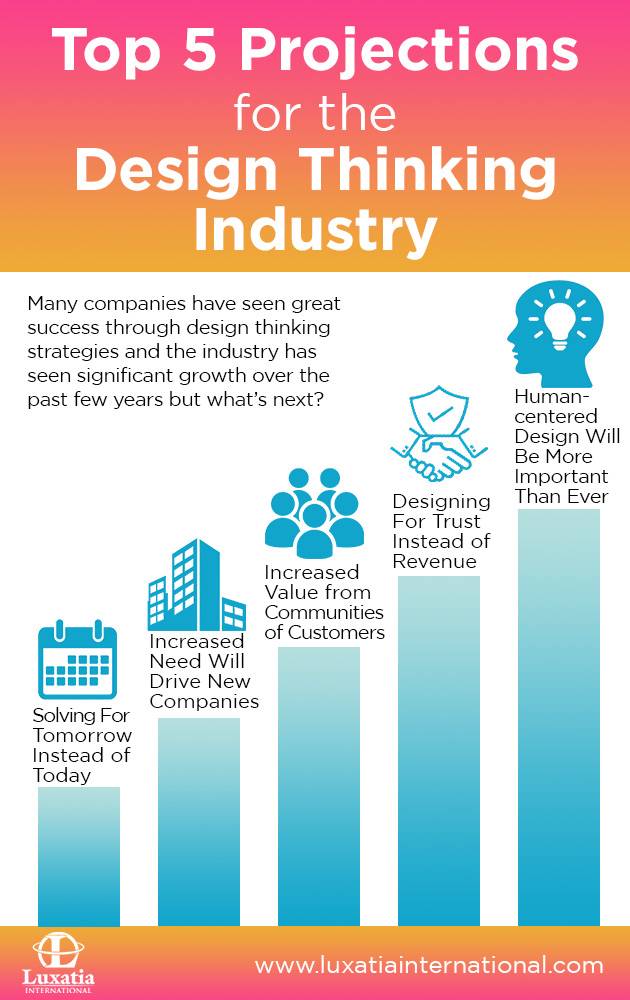Many companies have seen great success through design thinking strategies and the design thinking industry has seen significant growth over the past few years but what’s next? Has design thinking hit its peak already or will it continue to see growth through 2020?
Through market research, here are our top five projections for the design thinking industry:

Solving For Tomorrow Instead Of Today
Design thinking is great at solving the problems of today but what about tomorrow? One of the key growth aspects for the future of design thinking will be going beyond designing for today’s problems to create the sort of products and services that the world wants but doesn’t know it yet.
This type of future includes tools and methodologies coming from strategic business modeling, future casting tools (such as trend mapping), systems thinking tools, human-centered design tools and prototyping.
The future of the industry will be about using the concepts of strategic foresight and design thinking to embrace apprehension, identify opportunities, and make small but significant headway on those opportunities (or future ones).
Increased Need Will Drive New Companies
With continuous growth in the market and more businesses realising the importance of design thinking, there will be an increase in the need for companies specialising in this. Some experts are even predicting that design-consulting firms will be just as common as financial consulting firms will.
Design thinking will not only be associated with designing products but for services and internal processes as well. Many businesses are already finding design thinking solutions with the creative teams in their organisation but they will need to expand beyond these teams to drive their business into the future.
One example, for sales to see continued success, design thinking will be key to establishing a genuine connection with customers and engaging them throughout the sales process.
Increased Value from Communities of Customers
Businesses will need to start embracing a community-based approach to collaborating with their customers. This will be the new way to conduct market research, to support successful design thinking solutions.
Customer insight platforms such as Sparq, a Vision Critical product, will become paramount as the relationship between design and data science grows tighter. Some companies may be struggling to get the data they need after the implementation of GDPR so finding valuable customer insights through consent data might be what gives you a competitive edge.

Image Source: Visioncritical
Many global brands are already utilising customer insight platforms so the projection here is that many more companies will start to adopt this strategy.
Designing For Trust Instead Of Revenue
Organisations in all industries are seeing a lack of consumer trust but many people think design thinking can change that. By making empowered decisions on what content and design your consumers see, you can gain their trust back.
The product design must take a backseat until that loyalty is won back or you are just wasting time and money. The object will be less important than ever.
Previously, companies spent a lot of money on PR tactics to cover up even the slightest mistake but plan to see organisations being more vulnerable and using design thinking strategies to do so. If your customers feel respected by you and empowered with the information you are allowing them to know, they are more likely to be loyal for a longer period.
Human-centered Design Approach Will Be More Important Than Ever
In this technological age, it’s easy to get swept up in the race to create the latest and greatest product but the ability to empathise will see a huge increase in importance. Airbnb, Spotify and Oral B all saw drastic improvement once they took a human-centered design approach to the challenges they were facing.
It will be more important than ever to use psychographic, ethnographic, and sociocultural research to develop products that provide meaningful engagement and that will simplify our lives. Part of this will be companies creating products that learn and adapt to human needs – not wants.
A human-centered design approach will also be extremely important for bridging the generation gaps. Your company may be struggling to appease every generation in your workforce or your product may only appeal to one generation now but approaching your design thinking strategies with a human-centered approach will help solve these issues.
Look for areas of opportunity to utilise these projections in your own organisations and establish yourself as a long-lasting, innovative company that solves your target audience's needs and pain points. The concept of designing with the end-user in mind is not new to product design and as companies adopt design thinking in other areas of their business, we should continue to see growth in the market. Make sure your company is prepared and look for opportunities, like the projections above, to give you a competitive advantage.
Other areas of opportunity will be discussed during the 3rd Design Thinking Summit in Berlin, Germany on October 24th and 25th. Join global executives as they share their experiences and discuss the latest trends in design thinking innovations.

